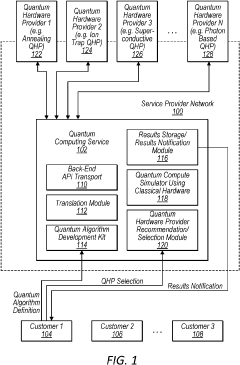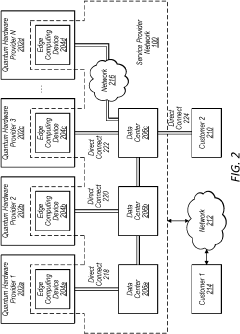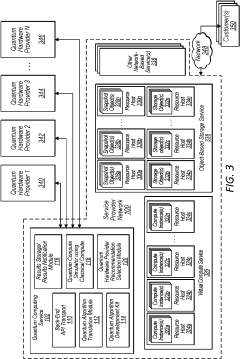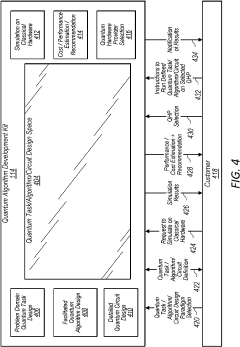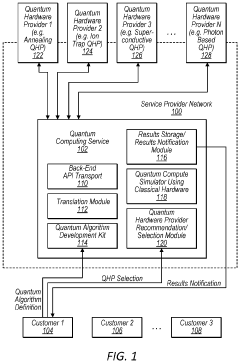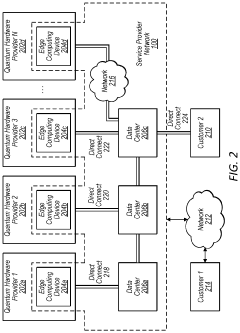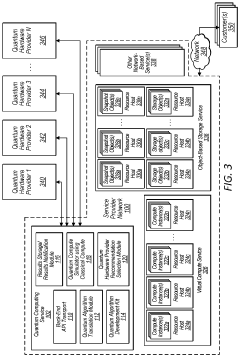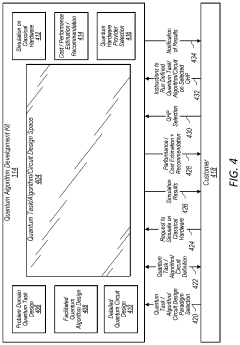How Throttle Body Technology Supports Quantum Computing Development
JUL 18, 20259 MIN READ
Generate Your Research Report Instantly with AI Agent
Patsnap Eureka helps you evaluate technical feasibility & market potential.
Quantum Computing and Throttle Body Synergy
The convergence of quantum computing and throttle body technology represents a fascinating intersection of cutting-edge physics and traditional mechanical engineering. Quantum computing, with its potential to revolutionize computational power, is constantly seeking new avenues for optimization and control. Throttle body technology, traditionally associated with internal combustion engines, offers precise control mechanisms that can be adapted to support quantum computing development.
At the core of this synergy is the concept of precision control. Quantum computers require exquisite control over quantum states, often at extremely low temperatures. The principles behind throttle body technology, which involve precise regulation of airflow, can be adapted to create ultra-fine control systems for quantum environments. These systems could potentially manage the flow of coolants, control the delivery of quantum particles, or regulate the electromagnetic fields crucial for maintaining quantum coherence.
Moreover, the expertise in miniaturization and precision manufacturing developed in the automotive industry for throttle bodies can be leveraged to create compact and highly accurate components for quantum computers. This includes the development of microelectromechanical systems (MEMS) that can operate in the quantum regime, providing the necessary interface between the macroscopic world and quantum systems.
Another area of potential synergy lies in the realm of error correction and noise reduction. Quantum computers are notoriously sensitive to environmental disturbances. The advanced sensor technologies and feedback control systems used in modern throttle bodies could be adapted to create more robust quantum error correction mechanisms. These systems could potentially detect and compensate for quantum decoherence in real-time, improving the stability and reliability of quantum computations.
Furthermore, the principles of fluid dynamics that govern throttle body operation could inspire new approaches to quantum information flow and qubit manipulation. By drawing parallels between the flow of air in an engine and the flow of quantum information, researchers might develop novel architectures for quantum circuits and quantum memory systems.
The integration of throttle body technology into quantum computing also opens up possibilities for hybrid quantum-classical systems. These systems could leverage the strengths of both paradigms, using classical control systems derived from throttle body technology to manage and optimize quantum processes. This hybrid approach could accelerate the development of practical quantum computers by bridging the gap between current technology and fully realized quantum systems.
At the core of this synergy is the concept of precision control. Quantum computers require exquisite control over quantum states, often at extremely low temperatures. The principles behind throttle body technology, which involve precise regulation of airflow, can be adapted to create ultra-fine control systems for quantum environments. These systems could potentially manage the flow of coolants, control the delivery of quantum particles, or regulate the electromagnetic fields crucial for maintaining quantum coherence.
Moreover, the expertise in miniaturization and precision manufacturing developed in the automotive industry for throttle bodies can be leveraged to create compact and highly accurate components for quantum computers. This includes the development of microelectromechanical systems (MEMS) that can operate in the quantum regime, providing the necessary interface between the macroscopic world and quantum systems.
Another area of potential synergy lies in the realm of error correction and noise reduction. Quantum computers are notoriously sensitive to environmental disturbances. The advanced sensor technologies and feedback control systems used in modern throttle bodies could be adapted to create more robust quantum error correction mechanisms. These systems could potentially detect and compensate for quantum decoherence in real-time, improving the stability and reliability of quantum computations.
Furthermore, the principles of fluid dynamics that govern throttle body operation could inspire new approaches to quantum information flow and qubit manipulation. By drawing parallels between the flow of air in an engine and the flow of quantum information, researchers might develop novel architectures for quantum circuits and quantum memory systems.
The integration of throttle body technology into quantum computing also opens up possibilities for hybrid quantum-classical systems. These systems could leverage the strengths of both paradigms, using classical control systems derived from throttle body technology to manage and optimize quantum processes. This hybrid approach could accelerate the development of practical quantum computers by bridging the gap between current technology and fully realized quantum systems.
Market Demand Analysis
The market demand for quantum computing technologies has been growing exponentially in recent years, driven by the potential to revolutionize various industries through unprecedented computational power. As quantum computing advances, the need for supporting technologies, including throttle body technology, becomes increasingly critical.
Quantum computing's market size is projected to reach significant levels by 2030, with estimates ranging from $5 billion to $10 billion. This growth is fueled by investments from major tech companies, governments, and research institutions worldwide. The demand spans across multiple sectors, including finance, healthcare, cybersecurity, and materials science, where quantum computing promises to solve complex problems that are currently intractable for classical computers.
In the context of quantum computing development, throttle body technology plays a crucial role in managing and controlling the flow of resources, particularly in the cooling systems essential for maintaining quantum states. The market for quantum-specific cooling solutions is expected to grow in tandem with the overall quantum computing market, as these systems are integral to the operation of quantum processors.
The financial sector shows particular interest in quantum computing for risk analysis, portfolio optimization, and fraud detection. Healthcare and pharmaceutical industries are exploring quantum computing for drug discovery and personalized medicine, potentially reducing the time and cost of bringing new treatments to market. These applications drive the demand for more stable and scalable quantum systems, which in turn increases the need for advanced throttle body technologies.
Governments and defense organizations are investing heavily in quantum technologies for national security applications, including cryptography and secure communications. This investment further stimulates the market for supporting technologies like advanced throttle bodies that can ensure the reliability and efficiency of quantum systems in high-stakes environments.
As quantum computers move from research labs to commercial applications, there is a growing demand for standardized and reliable components. Throttle body technology, adapted for quantum computing needs, is positioned to become a critical part of the quantum hardware supply chain. Manufacturers capable of producing high-precision, quantum-compatible throttle bodies are likely to see increased market opportunities.
The integration of quantum computing with other emerging technologies such as artificial intelligence and the Internet of Things is expected to create new market segments. These hybrid systems will require sophisticated control mechanisms, including advanced throttle body technologies, to manage the complex interplay between classical and quantum components.
Quantum computing's market size is projected to reach significant levels by 2030, with estimates ranging from $5 billion to $10 billion. This growth is fueled by investments from major tech companies, governments, and research institutions worldwide. The demand spans across multiple sectors, including finance, healthcare, cybersecurity, and materials science, where quantum computing promises to solve complex problems that are currently intractable for classical computers.
In the context of quantum computing development, throttle body technology plays a crucial role in managing and controlling the flow of resources, particularly in the cooling systems essential for maintaining quantum states. The market for quantum-specific cooling solutions is expected to grow in tandem with the overall quantum computing market, as these systems are integral to the operation of quantum processors.
The financial sector shows particular interest in quantum computing for risk analysis, portfolio optimization, and fraud detection. Healthcare and pharmaceutical industries are exploring quantum computing for drug discovery and personalized medicine, potentially reducing the time and cost of bringing new treatments to market. These applications drive the demand for more stable and scalable quantum systems, which in turn increases the need for advanced throttle body technologies.
Governments and defense organizations are investing heavily in quantum technologies for national security applications, including cryptography and secure communications. This investment further stimulates the market for supporting technologies like advanced throttle bodies that can ensure the reliability and efficiency of quantum systems in high-stakes environments.
As quantum computers move from research labs to commercial applications, there is a growing demand for standardized and reliable components. Throttle body technology, adapted for quantum computing needs, is positioned to become a critical part of the quantum hardware supply chain. Manufacturers capable of producing high-precision, quantum-compatible throttle bodies are likely to see increased market opportunities.
The integration of quantum computing with other emerging technologies such as artificial intelligence and the Internet of Things is expected to create new market segments. These hybrid systems will require sophisticated control mechanisms, including advanced throttle body technologies, to manage the complex interplay between classical and quantum components.
Current Challenges
The integration of throttle body technology into quantum computing development faces several significant challenges that require innovative solutions. One of the primary obstacles is the precise control of quantum states, which is crucial for maintaining coherence and performing accurate computations. Throttle body technology, traditionally used in automotive applications, must be adapted to the ultra-sensitive environment of quantum systems.
The miniaturization of throttle body components to the nanoscale level presents a formidable engineering challenge. Quantum computing requires manipulation of individual particles, necessitating the development of throttle mechanisms that can operate at the atomic level. This demands unprecedented precision in manufacturing and material science, pushing the boundaries of current fabrication techniques.
Another critical challenge lies in the thermal management of quantum systems. Quantum computers typically operate at extremely low temperatures to maintain quantum coherence. Integrating throttle body technology into this environment requires novel approaches to heat dissipation and thermal isolation. The mechanical nature of throttle bodies introduces potential sources of heat and vibration, which can disrupt the delicate quantum states.
The interface between classical control systems and quantum components poses a significant hurdle. Throttle body technology must be adapted to translate macroscopic control inputs into quantum-level manipulations without introducing decoherence. This requires the development of sophisticated transduction mechanisms and quantum-classical interfaces that can operate with minimal noise and interference.
Scalability remains a persistent challenge in quantum computing, and integrating throttle body technology must address this issue. As quantum systems grow in complexity and qubit count, the control mechanisms must scale accordingly without compromising performance or introducing additional sources of error. This demands innovative approaches to system architecture and control distribution.
The reliability and durability of throttle body components in the quantum computing environment are also areas of concern. Quantum systems often require long coherence times and stable operation over extended periods. Adapting throttle body technology to meet these stringent requirements necessitates advancements in materials science and design to ensure long-term stability and minimal wear.
Lastly, the integration of throttle body technology must overcome the challenge of quantum error correction. As quantum systems are inherently prone to errors due to environmental interactions, any control mechanism, including throttle bodies, must be designed to minimize error introduction and support error correction protocols. This requires a deep understanding of quantum error sources and the development of robust control strategies that can operate within the constraints of quantum error correction schemes.
The miniaturization of throttle body components to the nanoscale level presents a formidable engineering challenge. Quantum computing requires manipulation of individual particles, necessitating the development of throttle mechanisms that can operate at the atomic level. This demands unprecedented precision in manufacturing and material science, pushing the boundaries of current fabrication techniques.
Another critical challenge lies in the thermal management of quantum systems. Quantum computers typically operate at extremely low temperatures to maintain quantum coherence. Integrating throttle body technology into this environment requires novel approaches to heat dissipation and thermal isolation. The mechanical nature of throttle bodies introduces potential sources of heat and vibration, which can disrupt the delicate quantum states.
The interface between classical control systems and quantum components poses a significant hurdle. Throttle body technology must be adapted to translate macroscopic control inputs into quantum-level manipulations without introducing decoherence. This requires the development of sophisticated transduction mechanisms and quantum-classical interfaces that can operate with minimal noise and interference.
Scalability remains a persistent challenge in quantum computing, and integrating throttle body technology must address this issue. As quantum systems grow in complexity and qubit count, the control mechanisms must scale accordingly without compromising performance or introducing additional sources of error. This demands innovative approaches to system architecture and control distribution.
The reliability and durability of throttle body components in the quantum computing environment are also areas of concern. Quantum systems often require long coherence times and stable operation over extended periods. Adapting throttle body technology to meet these stringent requirements necessitates advancements in materials science and design to ensure long-term stability and minimal wear.
Lastly, the integration of throttle body technology must overcome the challenge of quantum error correction. As quantum systems are inherently prone to errors due to environmental interactions, any control mechanism, including throttle bodies, must be designed to minimize error introduction and support error correction protocols. This requires a deep understanding of quantum error sources and the development of robust control strategies that can operate within the constraints of quantum error correction schemes.
Existing Solutions
01 Electronic throttle control systems
Advanced throttle body technology incorporates electronic control systems to regulate airflow into the engine. These systems use sensors and actuators to precisely adjust the throttle position based on various inputs, improving engine performance and fuel efficiency.- Electronic throttle control systems: Advanced throttle body technology incorporates electronic control systems to regulate airflow into the engine. These systems use sensors and actuators to precisely adjust the throttle position based on various engine parameters and driver input, improving fuel efficiency and performance.
- Throttle body design improvements: Innovations in throttle body design focus on optimizing airflow characteristics and reducing turbulence. This includes refined shapes, improved butterfly valve designs, and the use of advanced materials to enhance durability and performance while minimizing weight.
- Integration of additional components: Modern throttle bodies often integrate additional components such as idle air control valves, throttle position sensors, and air temperature sensors. This integration simplifies the overall engine management system and improves reliability by reducing the number of separate components.
- Throttle body cleaning and maintenance technologies: Advancements in throttle body maintenance include self-cleaning mechanisms and specialized cleaning solutions. These technologies help prevent carbon buildup and ensure consistent performance over time, reducing the need for manual cleaning and maintenance.
- Variable geometry throttle bodies: Innovative throttle body designs incorporate variable geometry features that can adjust the shape or size of the air intake passage. This allows for optimized airflow across different engine speeds and load conditions, improving overall engine performance and efficiency.
02 Throttle body design improvements
Innovations in throttle body design focus on optimizing airflow characteristics and reducing turbulence. This includes refined shapes, improved sealing mechanisms, and integration of additional components to enhance overall engine performance and responsiveness.Expand Specific Solutions03 Integration of idle air control
Modern throttle bodies often incorporate idle air control mechanisms directly into their design. This integration allows for more precise control of engine idle speed and smoother transitions between idle and acceleration, improving overall drivability and emissions performance.Expand Specific Solutions04 Multi-valve throttle bodies
Advanced throttle body designs may incorporate multiple valves or butterflies to provide more precise control over airflow across different engine operating conditions. This approach can improve engine response and efficiency across a wider range of speeds and loads.Expand Specific Solutions05 Materials and manufacturing advancements
Throttle body technology has benefited from advancements in materials science and manufacturing processes. The use of lightweight, durable materials and precision manufacturing techniques has led to improved performance, longevity, and reduced manufacturing costs.Expand Specific Solutions
Key Industry Players
The development of throttle body technology in quantum computing is in its early stages, with the market still emerging and showing significant growth potential. The competitive landscape is characterized by a mix of established tech giants and specialized quantum computing firms. Companies like IBM, Google, and Intel are leveraging their extensive resources and expertise to advance quantum computing, while startups such as IonQ and D-Wave Systems are focusing exclusively on quantum technologies. The technology's maturity varies, with some players like IBM and Google demonstrating more advanced capabilities, while others are still in the research and development phase. As the field progresses, collaboration between academia and industry, exemplified by partnerships with institutions like Duke University and the University of Southern California, is becoming increasingly crucial for innovation and talent development.
International Business Machines Corp.
Technical Solution: IBM's approach to quantum computing involves superconducting qubits and a unique quantum volume metric. Their latest Osprey processor boasts 433 qubits[1], a significant increase from previous models. IBM integrates throttle body technology in their quantum systems for precise control of cryogenic cooling, crucial for maintaining qubit coherence. They employ electronic throttle bodies to regulate the flow of liquid helium, allowing for dynamic adjustment of cooling rates based on computational demands[2]. This integration enables IBM to achieve longer coherence times and improved qubit performance.
Strengths: Advanced qubit technology, industry-leading quantum volume, and sophisticated cryogenic control. Weaknesses: Scalability challenges and high operational costs associated with cryogenic systems.
Intel Corp.
Technical Solution: Intel's quantum efforts focus on spin qubits in silicon, leveraging their semiconductor manufacturing expertise. They utilize throttle body technology in their cryogenic control systems to manage the extreme cooling required for quantum chip operation. Intel's approach involves integrating throttle mechanisms directly into their quantum chips, allowing for localized temperature control at the qubit level[3]. This innovation enables more precise manipulation of individual qubits and potentially reduces the overall cooling requirements. Intel's Horse Ridge II cryogenic control chip incorporates these advanced throttling techniques to improve qubit performance and scalability[4].
Strengths: Leveraging existing semiconductor manufacturing infrastructure, potential for room-temperature operation. Weaknesses: Relatively lower qubit count compared to superconducting approaches, still in early stages of development.
Core Innovations
Quantum computing task translation supporting multiple quantum computing technologies
PatentPendingUS20230325730A1
Innovation
- A quantum computing service that provides access to multiple quantum computing technologies, enabling customers to define and execute quantum tasks, algorithms, or circuits without requiring specific knowledge of the underlying technologies, by selecting the most suitable hardware provider based on factors like cost, error rates, and run-time, and translating quantum objects into formats compatible with different quantum computing technologies for execution.
Quantum computing service supporting multiple quantum computing technologies
PatentActiveUS11704715B2
Innovation
- A quantum computing service that provides seamless access to multiple quantum computing technologies by receiving quantum computing objects from customers, translating them into suitable formats for different technologies, and executing them on appropriate hardware providers, while offering recommendations on cost, error rates, and run-time considerations.
Quantum-Throttle Integration
The integration of throttle body technology with quantum computing represents a groundbreaking approach to enhancing the performance and efficiency of quantum systems. This innovative fusion leverages the precise control mechanisms of throttle bodies to regulate the flow of quantum information, much like how they manage air intake in combustion engines.
At the core of this integration is the concept of quantum throttling, which involves the controlled manipulation of quantum states and their interactions. By adapting throttle body principles to quantum systems, researchers have developed methods to fine-tune the quantum flux, allowing for more accurate control over qubit operations and coherence times.
One key aspect of this integration is the development of quantum throttle gates. These specialized components act as quantum-mechanical analogues to traditional throttle bodies, regulating the flow of quantum information through superconducting circuits. By precisely modulating the quantum current, these gates enable more efficient qubit manipulation and reduce error rates in quantum computations.
The quantum-throttle integration also extends to the realm of quantum error correction. By implementing throttle-inspired control mechanisms, researchers have improved the stability of quantum states, mitigating the effects of decoherence and environmental noise. This enhancement in quantum error correction protocols has led to significant improvements in the overall reliability of quantum computations.
Furthermore, the application of throttle body principles has revolutionized quantum cooling systems. Quantum throttle coolers utilize the controlled expansion of quantum gases to achieve ultra-low temperatures, crucial for maintaining qubit coherence. This innovative cooling approach has enabled the development of more compact and efficient quantum computing hardware.
The synergy between throttle body technology and quantum computing has also given rise to novel quantum sensing applications. Quantum-throttle sensors leverage the precise control afforded by throttle mechanisms to enhance the sensitivity and resolution of quantum measurement devices, opening new avenues for applications in fields such as materials science and medical imaging.
As research in this area progresses, the quantum-throttle integration promises to address some of the most pressing challenges in quantum computing, including scalability and error rates. By harnessing the principles of throttle body technology, quantum researchers are paving the way for more robust and practical quantum computing systems, bringing us closer to the realization of large-scale quantum computers capable of solving complex real-world problems.
At the core of this integration is the concept of quantum throttling, which involves the controlled manipulation of quantum states and their interactions. By adapting throttle body principles to quantum systems, researchers have developed methods to fine-tune the quantum flux, allowing for more accurate control over qubit operations and coherence times.
One key aspect of this integration is the development of quantum throttle gates. These specialized components act as quantum-mechanical analogues to traditional throttle bodies, regulating the flow of quantum information through superconducting circuits. By precisely modulating the quantum current, these gates enable more efficient qubit manipulation and reduce error rates in quantum computations.
The quantum-throttle integration also extends to the realm of quantum error correction. By implementing throttle-inspired control mechanisms, researchers have improved the stability of quantum states, mitigating the effects of decoherence and environmental noise. This enhancement in quantum error correction protocols has led to significant improvements in the overall reliability of quantum computations.
Furthermore, the application of throttle body principles has revolutionized quantum cooling systems. Quantum throttle coolers utilize the controlled expansion of quantum gases to achieve ultra-low temperatures, crucial for maintaining qubit coherence. This innovative cooling approach has enabled the development of more compact and efficient quantum computing hardware.
The synergy between throttle body technology and quantum computing has also given rise to novel quantum sensing applications. Quantum-throttle sensors leverage the precise control afforded by throttle mechanisms to enhance the sensitivity and resolution of quantum measurement devices, opening new avenues for applications in fields such as materials science and medical imaging.
As research in this area progresses, the quantum-throttle integration promises to address some of the most pressing challenges in quantum computing, including scalability and error rates. By harnessing the principles of throttle body technology, quantum researchers are paving the way for more robust and practical quantum computing systems, bringing us closer to the realization of large-scale quantum computers capable of solving complex real-world problems.
Environmental Impact
The environmental impact of throttle body technology in quantum computing development is a complex and multifaceted issue that warrants careful consideration. As quantum computing systems become more advanced and widespread, the energy consumption and environmental footprint of these technologies are increasingly coming under scrutiny.
Throttle body technology, traditionally associated with internal combustion engines, has found innovative applications in the cooling systems of quantum computers. These systems require extremely low temperatures to maintain quantum coherence, often approaching absolute zero. The precise control offered by throttle body technology allows for more efficient cooling processes, potentially reducing the overall energy consumption of quantum computing systems.
However, the production and operation of throttle bodies for quantum computing applications still carry environmental implications. The manufacturing process involves the use of various materials, including metals and plastics, which have their own ecological footprints. The extraction and processing of these materials contribute to resource depletion and greenhouse gas emissions.
On the positive side, the integration of throttle body technology in quantum computing cooling systems may lead to more energy-efficient operations. By optimizing the flow of coolants and managing temperature fluctuations more effectively, these systems can potentially reduce the overall power consumption of quantum computers. This efficiency gain could translate into lower carbon emissions associated with the electricity used to power these advanced computing systems.
Furthermore, the application of throttle body technology in quantum computing may drive innovations in material science and manufacturing processes. As researchers and engineers strive to create more efficient and environmentally friendly components, new materials and production techniques may emerge. These advancements could have broader applications beyond quantum computing, potentially benefiting other industries and contributing to overall sustainability efforts.
It is also worth considering the indirect environmental impacts of quantum computing enabled by throttle body technology. Quantum computers have the potential to solve complex problems in fields such as climate modeling, energy optimization, and materials science. These applications could lead to breakthroughs in renewable energy technologies, more efficient transportation systems, and improved environmental monitoring capabilities.
In conclusion, while the environmental impact of throttle body technology in quantum computing development is not negligible, it must be weighed against the potential benefits and advancements that quantum computing may bring to environmental science and sustainability efforts. As the field progresses, it will be crucial to continue assessing and mitigating the ecological footprint of these technologies while maximizing their potential to address global environmental challenges.
Throttle body technology, traditionally associated with internal combustion engines, has found innovative applications in the cooling systems of quantum computers. These systems require extremely low temperatures to maintain quantum coherence, often approaching absolute zero. The precise control offered by throttle body technology allows for more efficient cooling processes, potentially reducing the overall energy consumption of quantum computing systems.
However, the production and operation of throttle bodies for quantum computing applications still carry environmental implications. The manufacturing process involves the use of various materials, including metals and plastics, which have their own ecological footprints. The extraction and processing of these materials contribute to resource depletion and greenhouse gas emissions.
On the positive side, the integration of throttle body technology in quantum computing cooling systems may lead to more energy-efficient operations. By optimizing the flow of coolants and managing temperature fluctuations more effectively, these systems can potentially reduce the overall power consumption of quantum computers. This efficiency gain could translate into lower carbon emissions associated with the electricity used to power these advanced computing systems.
Furthermore, the application of throttle body technology in quantum computing may drive innovations in material science and manufacturing processes. As researchers and engineers strive to create more efficient and environmentally friendly components, new materials and production techniques may emerge. These advancements could have broader applications beyond quantum computing, potentially benefiting other industries and contributing to overall sustainability efforts.
It is also worth considering the indirect environmental impacts of quantum computing enabled by throttle body technology. Quantum computers have the potential to solve complex problems in fields such as climate modeling, energy optimization, and materials science. These applications could lead to breakthroughs in renewable energy technologies, more efficient transportation systems, and improved environmental monitoring capabilities.
In conclusion, while the environmental impact of throttle body technology in quantum computing development is not negligible, it must be weighed against the potential benefits and advancements that quantum computing may bring to environmental science and sustainability efforts. As the field progresses, it will be crucial to continue assessing and mitigating the ecological footprint of these technologies while maximizing their potential to address global environmental challenges.
Unlock deeper insights with Patsnap Eureka Quick Research — get a full tech report to explore trends and direct your research. Try now!
Generate Your Research Report Instantly with AI Agent
Supercharge your innovation with Patsnap Eureka AI Agent Platform!
